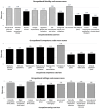Assessing occupational participation among justice-involved people 'with a personality disorder': Quantitative assessments and their properties
- PMID: 40336880
- PMCID: PMC11887891
- DOI: 10.1177/03080226241254768
Assessing occupational participation among justice-involved people 'with a personality disorder': Quantitative assessments and their properties
Abstract
Introduction: There is little evidence for what influences occupational participation for justice-involved people 'with a personality disorder' living in community contexts, and no validated occupational participation assessments specific to this group. We assessed a sample of justice-involved people 'with a personality disorder' to ascertain what influences occupational participation using commonly applied assessments and evaluated their construct validity.
Method: As part of a mixed-methods study, a purposive sample of 18 justice-involved people 'with a personality disorder' were scored on the Model of Human Occupational Screening Tool and Occupational Performance History Interview-Version Two scales. Mean scores were calculated per Model of Human Occupational Screening Tool (MOHOST) item and Occupational Performance History Interview-Version Two (OPHI-II) items and scales and compared to published data. Mann-Whitney U Tests were used to identify within-sample differences based on demographic characteristics.
Results: Participants had low scores on MOHOST items and OPHI-II items and scales. Differences were identified compared to published data. Within-sample differences were most apparent in comparisons by employment status and ethnicity. The OPHI-II scales did not operate as intended with this population and recommended adjustments impacted its construct validity.
Conclusion: Replication is required with a larger random sample. Integrating these data with qualitative exploration would further elucidate factors influencing occupational participation in this population.
Keywords: MOHOST; OPHI-II; Personality disorder; justice-involved; occupational participation; offender.
© The Author(s) 2024.
Conflict of interest statement
The author(s) declared no potential conflicts of interest with respect to the research, authorship, and/or publication of this article.
Figures
References
-
- Afifi TO, Mather A, Boman J, et al.. (2011) Childhood adversity and personality disorders: Results from a nationally representative population-based study. Journal of Psychiatric Research 45: 814–822. - PubMed
-
- Alred D. (2018) Service user perspectives of preparation for living in the community following discharge from a secure mental health unit. PhD Thesis. Brighton: University of Brighton.
-
- Black DW, Gunter T, Loveless P, et al.. (2010) Antisocial personality disorder in incarcerated offenders: Psychiatric comorbidity and quality of life. Annals of Clinical Psychiatry 22: 113–120. - PubMed
-
- Brooker C, Sirdifield C, Blizard R, et al.. (2012) Probation and mental illness. Journal of Forensic Psychiatry and Psychology 23: 522–537.
LinkOut - more resources
Full Text Sources
Research Materials


